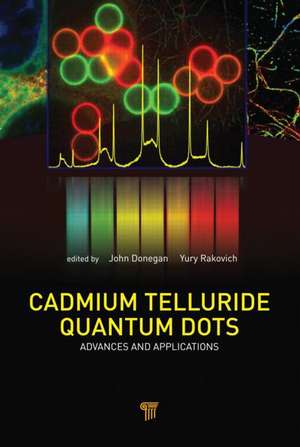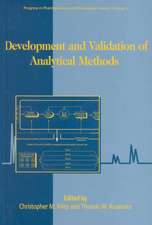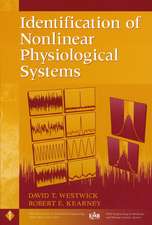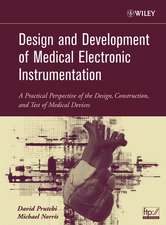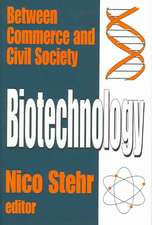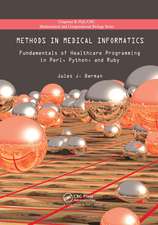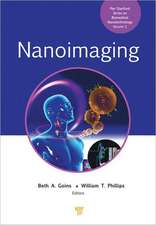Cadmium Telluride Quantum Dots: Advances and Applications
Editat de John Donegan, Yury Rakovichen Limba Engleză Hardback – 3 dec 2013
Cadmium Telluride Quantum Dots: Advances and Applications focuses on CdTe quantum dots and addresses their synthesis, assembly, optical properties, and applications in biology and medicine. It makes for a very informative reading for anyone involved in nanotechnology and will also benefit those scientists who are looking for a comprehensive account on the current state of quantum dot–related research.
Preț: 653.27 lei
Preț vechi: 876.95 lei
-26% Nou
Puncte Express: 980
Preț estimativ în valută:
125.02€ • 130.04$ • 103.21£
125.02€ • 130.04$ • 103.21£
Carte tipărită la comandă
Livrare economică 14-28 aprilie
Preluare comenzi: 021 569.72.76
Specificații
ISBN-13: 9789814316057
ISBN-10: 9814316059
Pagini: 248
Ilustrații: 84
Dimensiuni: 152 x 229 x 20 mm
Greutate: 0.48 kg
Ediția:1
Editura: Jenny Stanford Publishing
Colecția Jenny Stanford Publishing
ISBN-10: 9814316059
Pagini: 248
Ilustrații: 84
Dimensiuni: 152 x 229 x 20 mm
Greutate: 0.48 kg
Ediția:1
Editura: Jenny Stanford Publishing
Colecția Jenny Stanford Publishing
Public țintă
Academic and PostgraduateCuprins
Optical Properties of Bulk and Nanocrystalline Cadmium Telluride. Aqueous Synthesis of Colloidal CdTe Nanocrystals. Assemblies of Thiol-Capped CdTe Nanocrystals. Förster Resonant Energy Transfer in CdTe Nanocrystal Quantum Dot Structures. Emission of CdTe Nanocrystals Coupled to Microcavities. Biological Applications of Cadmium Telluride Semiconductor Quantum Dots. Biocompatibility and Cellular Localisation of CdTe Quantum Dots.
Notă biografică
Yury Rakovich received his diploma in physics from Belarusian State University, Belarus, and PhD in physics from the National Academy of Sciences of Belarus, Belarus, in 1995. He worked as a lecturer and associate professor in physics at the Brest State Technical University, Belarus, until 1997 and moved to the University of Minho, Portugal, in 1998. He joined the School of Physics at Trinity College Dublin in 2001, where he worked as a senior research fellow at the Centre for Research on Adaptive Nanostructures and Nanodevices (CRANN). Since 2010, he has been an Ikerbasque research professor leading the experimental nanophotonics group at Materials Physics Center, San Sebasian, Spain. He is also a part-time professor at the University of the Basque Country. Dr. Rakovich’s current research focuses on optics of microcavities and photonic molecules, nanophotonics, semiconductor nanocrystals, organic nanomaterials, and plasmonics.
John F. Donegan received his BSc and PhD from the National University of Ireland, Galway. He had postdoctoral periods at Lehigh University and the Max Planck Institute for Solid State Research, Stuttgart. He was appointed to the academic staff in Trinity College Dublin in 1993. He leads the Semiconductor Photonics Group and is also a principal investigator at the CRANN research institute in Trinity College Dublin. His research is in the area of photonics, in particular the interaction of light with photonic structures: microspheres and photonic molecules coupled with nanocrystal emission, tunable laser structures based on slotted lasers, and two-photon absorption microcavity structures.
John F. Donegan received his BSc and PhD from the National University of Ireland, Galway. He had postdoctoral periods at Lehigh University and the Max Planck Institute for Solid State Research, Stuttgart. He was appointed to the academic staff in Trinity College Dublin in 1993. He leads the Semiconductor Photonics Group and is also a principal investigator at the CRANN research institute in Trinity College Dublin. His research is in the area of photonics, in particular the interaction of light with photonic structures: microspheres and photonic molecules coupled with nanocrystal emission, tunable laser structures based on slotted lasers, and two-photon absorption microcavity structures.
Descriere
Among nanomaterials, CdTe holds special technological importance as the only known II–VI material that can form conventional p–n junctions. This makes CdTe very important for the development of novel optoelectronic devices such as light-emitting diodes, solar cells, and lasers. This book focuses on CdTe quantum dots and addresses their synthesis, assembly, optical properties, and applications in biology and medicine. It makes for a very informative reading for anyone involved in nanotechnology and will also benefit those scientists who are looking for a comprehensive account on the current state of quantum dot–related research.
